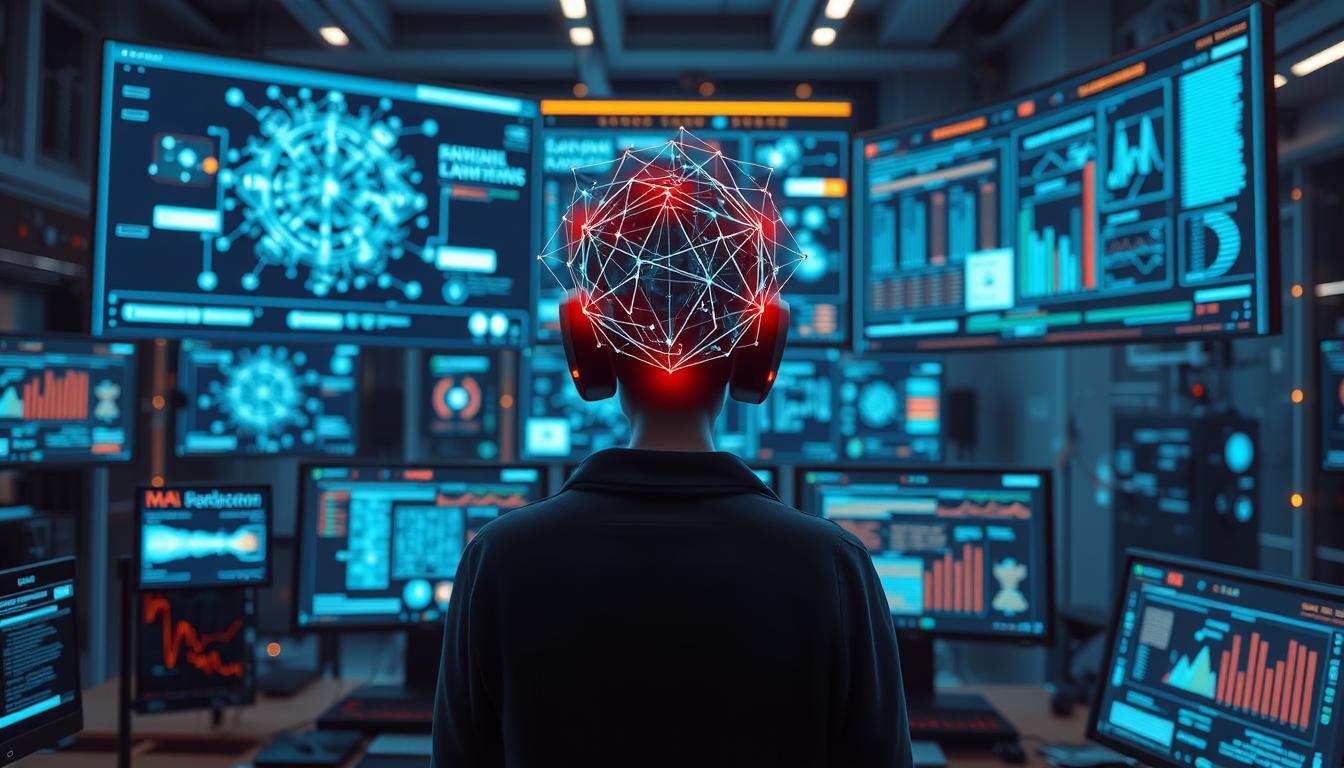According to recent studies, 84% of businesses now implement some form of artificial intelligence in their operations. Yet, this statistic only hints at the transformative journey we’re embarking on. The future of AI isn’t just approaching—it’s unfolding before our eyes, reshaping industries, challenging ethical boundaries, and redefining what’s possible. As we stand at this technological crossroads, understanding where AI is headed isn’t just fascinating—it’s essential for anyone looking to thrive in tomorrow’s world.
Whether you’re a business leader weighing AI investments, a professional concerned about job security, or simply curious about how these technologies will affect daily life, this exploration of AI’s future offers insights that matter. What might seem like science fiction today could be commonplace by 2030—are you prepared for that reality?
The Current State of AI: Setting the Stage for the Future
Modern AI systems leverage neural networks and vast datasets to perform increasingly complex tasks
Before we peer into the future of AI, let’s establish where we stand today. Current AI systems excel at narrow tasks—what experts call “narrow AI” or “weak AI.” These systems can outperform humans in specific domains like image recognition, language translation, and even complex games like chess and Go, but they lack the general intelligence that humans possess.
The backbone of today’s AI revolution is machine learning, particularly deep learning with neural networks. These systems learn from vast amounts of data rather than following explicitly programmed instructions. The most advanced models, like large language models (LLMs), contain billions of parameters and are trained on diverse datasets encompassing much of the internet.
What makes today’s AI landscape particularly exciting is the democratization of these technologies. Tools that were once confined to research labs are now accessible through APIs and user-friendly interfaces, allowing businesses of all sizes to implement AI solutions. This accessibility has accelerated adoption across industries, from healthcare diagnostics to financial forecasting.
Key AI Technologies Driving Current Innovation
Natural Language Processing
NLP has seen remarkable advances, enabling machines to understand, generate, and translate human language with unprecedented accuracy. Applications range from chatbots and virtual assistants to content generation and sentiment analysis.
Computer Vision
AI systems can now identify objects, recognize faces, and interpret visual scenes with superhuman precision. This technology powers everything from autonomous vehicles to medical imaging diagnostics and retail inventory management.
Reinforcement Learning
This approach allows AI to learn optimal behaviors through trial and error, receiving rewards for desired actions. It’s the technology behind AI systems that master complex games and is increasingly applied to robotics and process optimization.
Generative AI
Perhaps the most visible recent breakthrough, generative AI can create new content—from images and music to code and text—that often appears indistinguishable from human-created work. This has opened new frontiers in creative industries and software development.
Near-Term Future of AI: 2024-2027
The next three years will likely see AI’s integration deepen across industries, with several key trends emerging that build upon current capabilities rather than representing radical departures. These developments will primarily enhance existing systems while making them more accessible, efficient, and specialized.
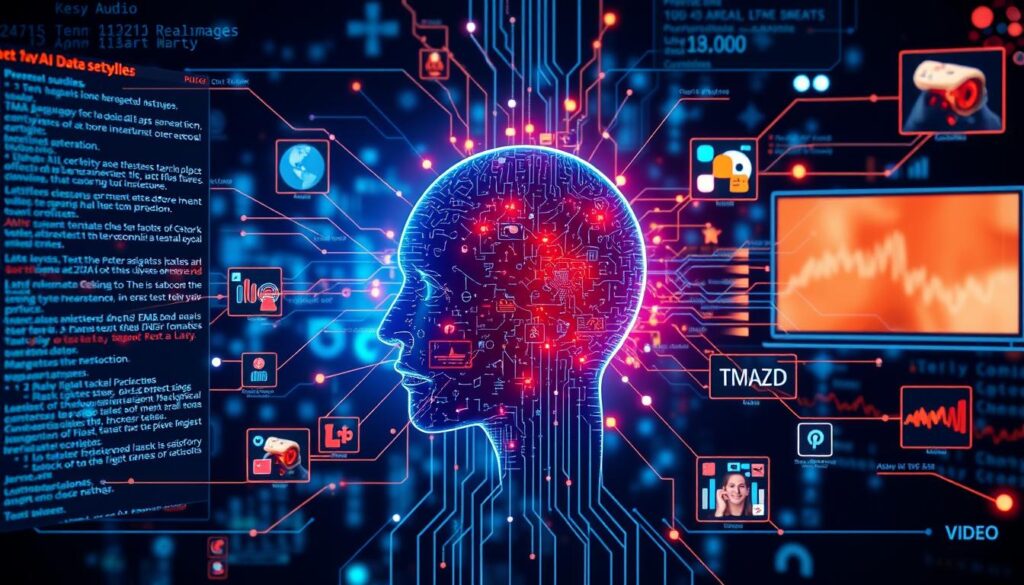
Multimodal AI systems will increasingly process different types of data simultaneously
Multimodal AI Takes Center Stage
While current AI systems typically excel in single domains (text, images, or audio), the immediate future will bring more sophisticated multimodal models. These systems will seamlessly integrate different types of data—understanding the relationship between text and images, audio and video, or even physical sensor data. Imagine virtual assistants that can interpret your tone of voice alongside your words, or content creation tools that generate cohesive multimedia presentations from simple prompts.
This shift toward multimodal AI will make human-computer interaction feel more natural and intuitive. Rather than adapting our communication to fit machine constraints, the machines will adapt to our natural ways of expressing information across multiple channels.
AI Becomes More Efficient and Accessible
The trend toward smaller, more efficient AI models will accelerate. While massive models like GPT-4 and Claude 3 demonstrate impressive capabilities, their size makes them expensive to run and maintain. In response, we’ll see the development of specialized “small language models” (SLMs) that deliver comparable performance for specific tasks at a fraction of the computational cost.
This efficiency drive will democratize access to advanced AI capabilities. Small businesses that couldn’t afford to implement cutting-edge AI will find more cost-effective options tailored to their needs. The result will be wider adoption across market segments previously priced out of the AI revolution.
The Rise of AI Agents and Automation
AI agents—autonomous systems that can perform complex tasks with minimal human supervision—will become increasingly common in business environments. These agents will move beyond simple automation to handle multi-step processes that require judgment and adaptation.
For example, an AI agent might manage a company’s entire customer support workflow, from initial contact to resolution, only escalating truly exceptional cases to human supervisors. Similarly, in software development, AI coding assistants will evolve from suggestion tools to active participants that can implement entire features based on high-level specifications.
Stay Ahead of AI Developments
The AI landscape is evolving rapidly. Subscribe to our AI Policy Watch newsletter to receive curated insights on the most important developments in artificial intelligence, delivered straight to your inbox.
Industry-Specific AI Solutions Proliferate
While general-purpose AI models grab headlines, the near future will see explosive growth in specialized AI systems trained on industry-specific data. These vertical AI solutions will outperform general models in their domains by incorporating specialized knowledge and terminology.
In healthcare, AI systems will be trained on medical literature, clinical notes, and imaging data to assist with diagnosis and treatment planning. In legal contexts, models will analyze case law and contracts with deeper understanding of legal principles. Financial services will deploy AI that comprehends complex regulations and market dynamics.
This specialization will deliver more immediate value to businesses than general-purpose AI, driving adoption in traditionally conservative sectors that have been slower to embrace these technologies.
Long-Term Future of AI: 2030 and Beyond
Looking further ahead, the future of AI becomes both more exciting and more uncertain. While near-term predictions extend current trends, long-term forecasts must account for potential breakthroughs that could fundamentally alter AI’s capabilities and impact. Experts suggest several transformative developments may emerge by 2030 and beyond.
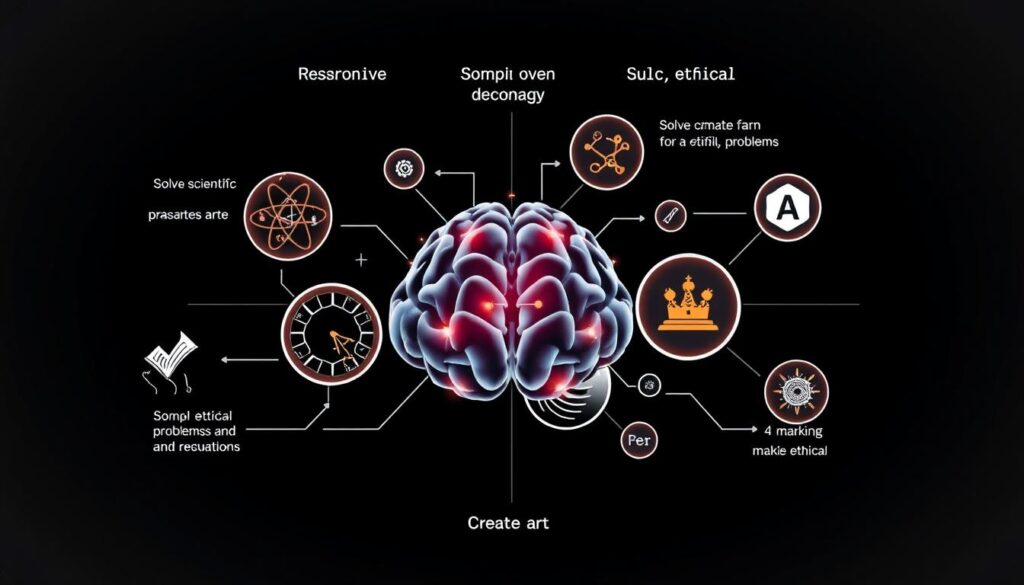
AGI would demonstrate human-like reasoning capabilities across diverse domains
The Pursuit of Artificial General Intelligence
Perhaps the most profound potential development is progress toward Artificial General Intelligence (AGI)—AI systems with human-like ability to reason across domains, transfer knowledge between tasks, and adapt to novel situations. While full AGI remains speculative, we may see systems that demonstrate increasingly general capabilities.
Rather than a sudden breakthrough, AGI would likely emerge gradually as models become more flexible and require less task-specific training. By 2030, we might see AI systems that can perform hundreds of different tasks competently after minimal instruction, representing a significant step toward generality.
The implications would be profound. An AI system that could generalize knowledge would accelerate scientific discovery by connecting insights across disciplines. It could revolutionize education by adapting perfectly to individual learning styles. And it would transform business by handling unprecedented situations without human intervention.
Quantum AI: A Computational Revolution
The intersection of quantum computing and artificial intelligence represents another frontier with transformative potential. Quantum computers leverage quantum mechanical phenomena to perform certain calculations exponentially faster than classical computers. As these systems mature, they could unlock new possibilities for AI.
Quantum machine learning algorithms might efficiently solve problems that are computationally intractable for classical systems. This could enable breakthroughs in materials science, drug discovery, and optimization problems that impact everything from supply chains to climate modeling.
While quantum computing faces significant engineering challenges, by 2030 we may see the first commercially viable quantum AI applications in specialized domains, with broader impact following as the technology matures.
Brain-Computer Interfaces and AI
The future of AI isn’t just about autonomous systems—it’s also about new ways humans and AI can collaborate. Brain-computer interfaces (BCIs) that allow direct communication between the human brain and computers represent one of the most fascinating frontiers.
Early commercial BCIs might enable “thought typing” or direct control of digital interfaces, dramatically accelerating human-computer interaction. Combined with AI that can interpret and respond to neural signals, these technologies could create unprecedented human augmentation capabilities.
By 2030, we might see professionals in fields like design, engineering, and creative arts using non-invasive BCIs to work in partnership with AI systems, thinking of concepts that the AI then helps visualize and refine in real-time.
AI-Powered Scientific Discovery
Perhaps the most profound long-term impact of AI will be its ability to accelerate scientific discovery. AI systems are already demonstrating the ability to generate hypotheses, design experiments, and interpret results in fields from biology to physics.
As these capabilities advance, we may enter an era of AI-assisted scientific breakthroughs. Systems that can analyze the entire corpus of scientific literature, connect seemingly unrelated findings, and suggest novel approaches could help solve some of humanity’s most pressing challenges—from climate change to disease.
By 2030, it’s plausible that major scientific journals will regularly publish papers where AI systems are credited as co-authors or even primary investigators on groundbreaking research.
Ethical Concerns in the Future of AI
As AI capabilities expand, so too do the ethical challenges associated with these technologies. Addressing these concerns isn’t just a moral imperative—it’s essential for building sustainable AI systems that earn public trust and deliver long-term value.
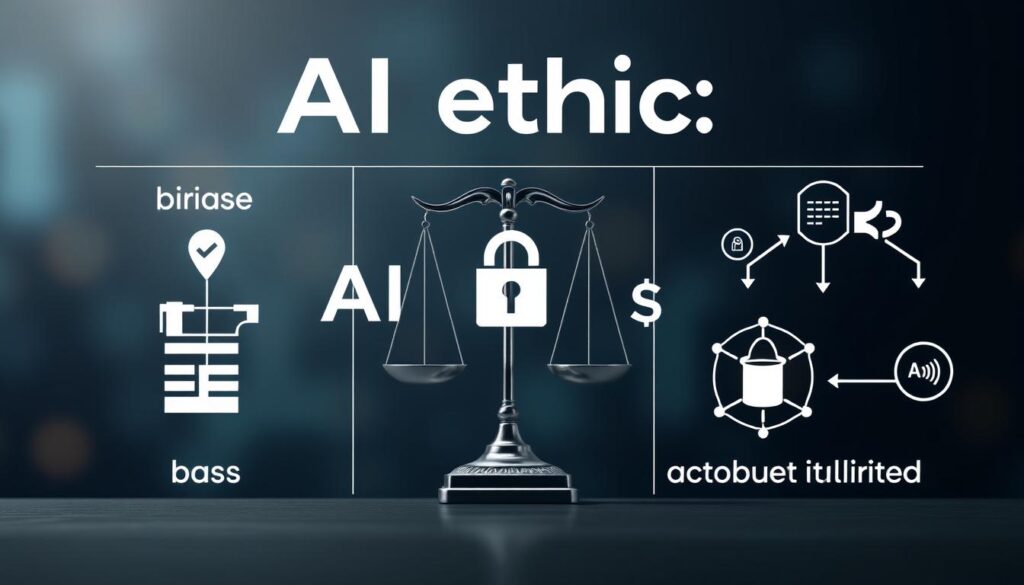
Ethical AI development requires addressing bias, privacy, and accountability challenges
Bias and Fairness in AI Systems
AI systems learn from data that often reflects historical biases and inequities. Without careful mitigation, these systems risk amplifying and perpetuating discrimination. As AI becomes more integrated into high-stakes decisions—from hiring to healthcare to criminal justice—ensuring fairness becomes increasingly critical.
Future approaches will likely combine technical solutions (like algorithmic fairness techniques) with procedural safeguards (like diverse development teams and impact assessments). The most promising developments involve AI systems that can explain their reasoning, allowing humans to identify and correct biased patterns.
By 2027, we may see regulatory frameworks that mandate fairness assessments for AI systems in sensitive domains, similar to environmental impact studies for construction projects.
Privacy in an AI-Powered World
Advanced AI thrives on data, creating tension with privacy values. As systems become more capable of extracting insights from seemingly innocuous information, traditional anonymization techniques may prove insufficient. The future of AI privacy will require more sophisticated approaches.
Federated learning—where models are trained across distributed devices without centralizing sensitive data—represents one promising direction. Privacy-preserving AI techniques that allow systems to learn from encrypted data without accessing the underlying information offer another avenue.
The most forward-thinking organizations are already exploring “privacy by design” approaches that build data protection into AI systems from the ground up, rather than treating it as an afterthought.
Benefits of AI Advancement
- Accelerated scientific discovery and innovation
- Improved healthcare diagnostics and treatment
- Enhanced productivity across industries
- More personalized education and services
- Potential solutions to complex global challenges
Ethical Challenges to Address
- Algorithmic bias and discrimination
- Privacy and data protection concerns
- Job displacement and economic disruption
- Concentration of power in tech companies
- Autonomous systems accountability
Accountability and Control
As AI systems become more autonomous and their decision-making more opaque, questions of accountability become increasingly complex. Who is responsible when an AI system causes harm? How can we ensure these systems remain aligned with human values and intentions?
The future will likely see the development of robust governance frameworks that distribute responsibility among developers, deployers, and users of AI systems. Technical approaches to interpretability and explainability will advance, making AI reasoning more transparent to human overseers.
Perhaps most importantly, we’ll need to develop better methods for specifying what we want AI systems to do—ensuring they optimize for human well-being rather than simplistic metrics that might lead to unintended consequences.
The Challenge of Deepfakes and Misinformation
Generative AI’s ability to create convincing fake content—from text to images to video—presents profound challenges for information integrity. As these technologies advance, distinguishing authentic from artificial content will become increasingly difficult.
Technical solutions like digital watermarking and content provenance systems will play a role in addressing this challenge. Equally important will be media literacy education that helps people critically evaluate the information they encounter.
By 2030, we may see an arms race between generative AI and detection systems, with significant implications for public discourse, elections, and international relations.
Economic Impact and Job Transformation
The future of AI will bring profound economic changes, reshaping labor markets and business models. Understanding these shifts is essential for individuals, organizations, and policymakers preparing for tomorrow’s economy.

The future workplace will feature humans and AI systems collaborating on complex tasks
Job Displacement and Creation
AI will continue to automate routine cognitive tasks, potentially displacing millions of jobs. According to Oxford Economics, up to 20 million manufacturing jobs worldwide could be automated by 2030. However, history suggests technological revolutions ultimately create more jobs than they eliminate—though often in different sectors requiring new skills.
The jobs most resistant to automation will be those requiring creative thinking, emotional intelligence, and complex problem-solving. Meanwhile, entirely new job categories will emerge around AI development, deployment, and oversight. Roles like “AI ethicist,” “human-AI collaboration specialist,” and “algorithmic auditor” may become commonplace.
The transition will be uneven, potentially exacerbating inequality if not managed thoughtfully. Regions and demographics with less access to education and retraining opportunities may face disproportionate challenges.
Business Model Transformation
AI will enable new business models while rendering others obsolete. Companies that effectively integrate AI into their operations can expect significant productivity gains—McKinsey estimates AI could add $13 trillion to global economic output by 2030.
Personalization at scale will become the norm, with businesses able to tailor products and services to individual preferences without prohibitive costs. Predictive capabilities will transform inventory management, maintenance scheduling, and resource allocation across industries.
Perhaps most significantly, AI will accelerate the shift from product-centric to service-centric business models. Physical products will increasingly serve as platforms for AI-powered services that continuously adapt to user needs and generate recurring revenue.
| Industry | Potential AI Impact by 2030 | Job Transformation | Required Skills Shift |
| Healthcare | Diagnostic automation, personalized treatment plans, drug discovery acceleration | Reduced need for diagnostic technicians, increased demand for AI-healthcare specialists | Medical professionals will need data interpretation skills and AI collaboration abilities |
| Financial Services | Automated underwriting, algorithmic trading, personalized financial advice | Fewer traditional analysts, more AI oversight roles and client relationship managers | Financial expertise combined with data science and ethical AI governance |
| Manufacturing | Predictive maintenance, autonomous factories, AI-optimized supply chains | Reduction in assembly roles, growth in AI-physical systems management | Technical oversight, robotics collaboration, systems thinking |
| Education | Personalized learning paths, automated grading, AI tutors for basic subjects | Teachers become learning coaches and emotional/social development specialists | Curriculum design for AI-enhanced learning, emotional intelligence, creativity facilitation |
Productivity Paradox and Adoption Challenges
Despite AI’s potential, organizations may face a “productivity paradox” similar to what occurred during previous technological revolutions—where significant investments initially yield disappointing returns. Successful AI implementation requires not just technology deployment but organizational transformation.
Companies will need to redesign workflows, rethink decision-making processes, and develop new management approaches to fully capture AI’s benefits. Those that treat AI as a simple plug-and-play solution will likely be disappointed by the results.
The most successful organizations will be those that view AI as a collaborative partner for human workers rather than a replacement. This “augmentation” approach typically delivers better outcomes than pure automation strategies.
AI Policy and Regulation: Shaping the Future
As AI’s impact grows, so too does the importance of thoughtful governance frameworks. The policies and regulations established in the coming years will significantly influence how AI develops and who benefits from these technologies.
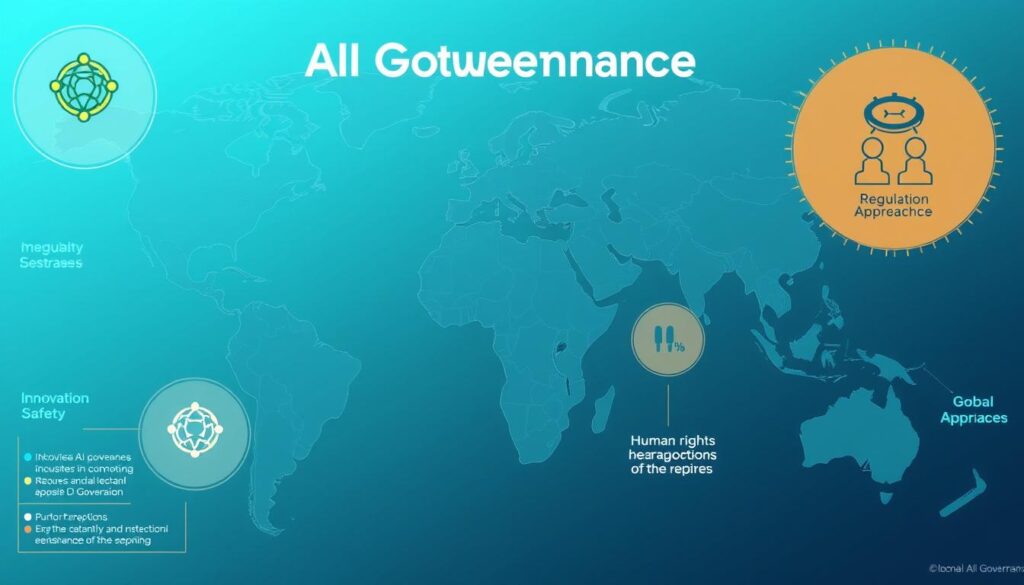
Effective AI governance requires balancing innovation with appropriate safeguards
The Emerging Regulatory Landscape
Governments worldwide are developing approaches to AI governance, with significant divergence in priorities and methods. The European Union’s AI Act represents the most comprehensive regulatory framework to date, taking a risk-based approach that imposes stricter requirements on high-risk applications while allowing more flexibility for lower-risk uses.
The United States has thus far favored a lighter touch, emphasizing voluntary guidelines and sector-specific regulations. China has pursued a dual strategy of aggressive AI development alongside tight control of certain applications, particularly those related to information flows and social governance.
By 2027, we’ll likely see greater regulatory convergence as best practices emerge and international coordination increases. However, significant differences will remain, reflecting varying cultural values and governance traditions.
Key Policy Challenges
Policymakers face several thorny challenges in developing effective AI governance. First is the “pacing problem”—regulations typically develop more slowly than the technologies they aim to govern. This creates risk that rules will be outdated before they’re implemented or will stifle innovation with inappropriate constraints.
Second is the challenge of expertise. Effective AI governance requires technical understanding that many policymakers lack. Bridging this knowledge gap without ceding regulatory authority to industry will be crucial.
Finally, there’s the challenge of international coordination. AI development is global, making purely national approaches increasingly inadequate. Yet different countries have divergent interests and values, complicating efforts to establish common standards.
Balancing Innovation and Safety
Perhaps the central tension in AI policy is balancing innovation with appropriate safeguards. Overly restrictive approaches risk hampering beneficial developments and ceding technological leadership to regions with lighter regulation. Conversely, inadequate oversight could allow harmful applications to proliferate.
The most promising governance models embrace “adaptive regulation”—frameworks that evolve alongside the technology, with regular reassessment based on emerging evidence. These approaches often combine binding rules for high-risk applications with flexibility for experimentation in lower-risk domains.
Industry self-regulation will play an important complementary role, with technical standards and best practices helping to establish norms that may eventually inform formal regulations.
“The challenge we face is not choosing between innovation and safety, but rather designing governance systems that promote both simultaneously. The future of AI will be shaped not just by what’s technically possible, but by the rules and norms we establish today.”
The Role of Global Cooperation
As AI capabilities advance, international cooperation becomes increasingly important. Powerful AI systems could affect global stability through applications in cyberwarfare, disinformation, or autonomous weapons. Managing these risks requires coordination across national boundaries.
We’re beginning to see the emergence of international forums focused on AI governance, from technical standards bodies to diplomatic initiatives. By 2030, we may see AI treaties similar to those governing nuclear technology, establishing shared guardrails for the most powerful systems.
The degree to which countries can find common ground on AI governance will significantly influence whether the technology’s benefits are broadly shared and its risks effectively managed.
Future Research Directions in AI
The future of AI will be shaped by breakthroughs in research that push beyond current limitations. Several promising research directions could lead to qualitative leaps in AI capabilities over the coming decade.

Neuromorphic computing architectures draw inspiration from the human brain’s neural structure
Beyond Deep Learning
While deep learning has driven remarkable progress, researchers recognize its limitations. Current systems require enormous amounts of data, struggle with causal reasoning, and often fail to generalize beyond their training distribution. Several research directions aim to address these shortcomings.
Neuro-symbolic approaches combine neural networks with symbolic reasoning systems, potentially offering the pattern recognition strengths of deep learning alongside the logical reasoning capabilities of traditional AI. Self-supervised learning reduces dependence on labeled data by having systems learn from the inherent structure of unlabeled data.
Perhaps most ambitiously, some researchers are exploring entirely new computational paradigms inspired by cognitive science and neuroscience, seeking architectures that more closely mimic human learning and reasoning.
Energy-Efficient AI
The environmental footprint of AI is growing rapidly, with training runs for large models consuming enormous amounts of energy. This has spurred research into more efficient approaches that deliver comparable capabilities with fewer resources.
Neuromorphic computing—hardware designed to mimic neural structures—offers potential energy efficiency gains of several orders of magnitude compared to conventional processors. Specialized AI chips tailored to specific workloads can dramatically reduce power consumption compared to general-purpose hardware.
Algorithm innovations like sparse attention mechanisms and model distillation also show promise for reducing computational requirements without sacrificing performance.
Robust and Trustworthy AI
As AI systems take on more critical roles, ensuring their reliability becomes paramount. Current models can fail in unpredictable ways when encountering novel situations or adversarial inputs. Research into robustness aims to address these vulnerabilities.
Approaches include adversarial training (exposing systems to deliberately challenging examples), uncertainty quantification (enabling models to express confidence levels in their outputs), and formal verification (mathematically proving that systems will behave as intended within certain bounds).
Interpretability research seeks to make AI decision-making more transparent, allowing humans to understand why systems reach particular conclusions and identify potential biases or errors.
Human-AI Collaboration
Rather than viewing AI development as a path to full automation, many researchers are exploring how AI and humans can most effectively work together. This collaborative approach recognizes the complementary strengths of human and artificial intelligence.
Research in this area includes developing interfaces that make AI capabilities more accessible to non-technical users, creating systems that can explain their reasoning in human-understandable terms, and designing AI that can learn from natural human feedback rather than requiring specialized training data.
The goal is to create AI that amplifies human capabilities rather than simply replacing human labor—potentially leading to more beneficial outcomes than either humans or AI could achieve alone.
Practical Implications: Preparing for the AI Future
With AI poised to transform industries and society, individuals and organizations must prepare strategically. Those who anticipate these changes will be better positioned to thrive in an AI-powered future.

Strategic AI implementation requires careful planning and cross-functional collaboration
For Individuals: Skills for an AI-Enhanced World
As AI automates routine cognitive tasks, the most valuable human skills will be those that complement rather than compete with machine capabilities. Creative thinking, emotional intelligence, ethical judgment, and interdisciplinary problem-solving will become increasingly prized in the labor market.
Technical literacy—not necessarily programming expertise, but the ability to understand AI’s capabilities and limitations—will become an essential skill across professions. Those who can effectively collaborate with AI systems, directing their capabilities toward meaningful goals, will have significant advantages.
Continuous learning will be more important than ever, as technological change accelerates the obsolescence of specific skills. The most successful individuals will be those who develop adaptability and learning strategies that allow them to evolve alongside technology.
For Organizations: Strategic AI Implementation
Organizations preparing for the future of AI should focus on building foundational capabilities rather than chasing the latest trends. This includes developing data infrastructure, cultivating AI literacy among leadership, and establishing governance frameworks that balance innovation with risk management.
Successful AI implementation requires more than technology—it demands organizational transformation. Business processes, decision-making structures, and performance metrics may all need redesign to fully capture AI’s benefits. The most effective approaches typically start with clear business problems rather than technology-first solutions.
As AI becomes more powerful, ethical considerations become business imperatives. Organizations that establish robust processes for assessing the societal impact of their AI applications will be better positioned to avoid reputational damage and regulatory challenges.
How quickly will AI transform my industry?
The pace of AI-driven transformation varies significantly across industries. Sectors with digitized processes, abundant data, and clear use cases—like financial services and e-commerce—are already seeing substantial impacts. Others with physical constraints, regulatory complexity, or less digitized operations may transform more gradually.
However, the rate of change is accelerating across all sectors. Organizations should conduct regular assessments of how AI is affecting their competitive landscape and be prepared to adapt more quickly than historical technological transitions might suggest.
Should I be worried about AI taking my job?
Rather than thinking in terms of entire jobs being automated, it’s more accurate to consider which tasks within jobs are susceptible to automation. Most roles will be transformed rather than eliminated, with AI handling routine aspects while humans focus on areas requiring judgment, creativity, and interpersonal skills.
The best preparation is developing adaptability and focusing on uniquely human capabilities. Those who can effectively collaborate with AI—directing its capabilities toward valuable ends—will likely find expanded opportunities rather than diminished ones.
How can small businesses compete in an AI-powered economy?
While large companies have advantages in data volume and AI investment capacity, several factors are democratizing access to AI capabilities. Cloud-based AI services, pre-trained models, and no-code tools are making sophisticated capabilities available without massive infrastructure investments.
Small businesses can compete by focusing on niche applications where their domain expertise provides an edge in training and deploying AI. They can also leverage AI to enhance their traditional strengths in personalization and customer relationships, areas where they often already outperform larger competitors.
For Policymakers: Governance for Shared Prosperity
Policymakers face the challenge of fostering AI innovation while ensuring its benefits are broadly shared and its risks effectively managed. This requires developing governance frameworks that can evolve alongside rapidly advancing technology.
Education and workforce development policies will be crucial for managing AI’s labor market impacts. This includes not just technical training but also developing the creative, social, and analytical skills that will complement AI capabilities.
Competition policy will need reconsideration in light of AI’s tendency toward concentration. The data advantages that accrue to early leaders can create self-reinforcing dynamics that make markets less contestable over time.
Perhaps most importantly, policymakers must ensure that AI development includes diverse perspectives. Systems trained primarily on data from and by privileged groups risk embedding and amplifying existing societal inequities.
Conclusion: Navigating the AI Future
The future of AI promises profound transformation across society, economy, and human experience. While precise predictions remain challenging, the trajectory is clear: AI capabilities will continue to advance rapidly, enabling systems that can perform an increasingly broad range of cognitive tasks at human or superhuman levels.

The future of AI will be shaped by the choices we make today about development and governance
This technological evolution brings both extraordinary opportunities and significant challenges. AI could help solve some of humanity’s most pressing problems—from climate change to disease—while creating unprecedented prosperity. Yet it also raises profound questions about privacy, autonomy, equity, and the very nature of work and human purpose.
The future that emerges will depend not just on what becomes technically possible, but on the choices we make as individuals, organizations, and societies. Will we prioritize short-term competitive advantage or long-term beneficial development? Will we ensure AI’s benefits are broadly shared or allow them to concentrate among the already privileged? Will we develop governance frameworks that harness AI’s potential while effectively managing its risks?
What’s certain is that the window for shaping AI’s trajectory remains open. The decisions we make in the coming years—about research directions, business models, regulatory approaches, and ethical frameworks—will have lasting consequences for how this transformative technology unfolds.
By approaching these choices thoughtfully, with an appreciation for both AI’s promise and its potential pitfalls, we can work toward a future where artificial intelligence serves as a powerful tool for human flourishing rather than a force that diminishes human agency and well-being.
